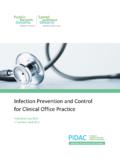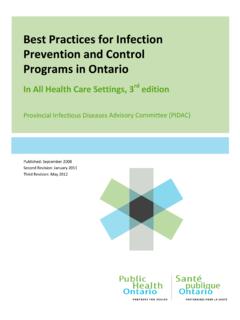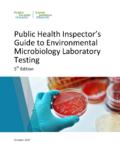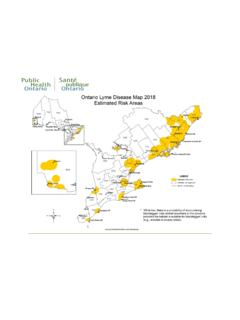Transcription of Best Practices for Cleaning, Disinfection and ...
1 Best Practices for Cleaning, Disinfection and Sterilization of Medical Equipment/Devices In All Health Care Settings, 3rd edition May 2013 Best Practices for Cleaning, Disinfection and Sterilization in All Health Care Settings | May 2013 ii The Ontario Agency for Health Protection and Promotion (Public Health Ontario) is a Crown corporation dedicated to protecting and promoting the health of all Ontarians and reducing inequities in health. As a hub organization, Public Health Ontario links public health practitioners, front-line health workers and researchers to the best scientific intelligence and knowledge from around the world. Public Health Ontario provides expert scientific and technical support relating to communicable and infectious diseases; surveillance and epidemiology; health promotion, chronic disease and injury prevention; environmental and occupational health; health emergency preparedness; and public health laboratory services to support health providers, the public health system and partner ministries in making informed decisions and taking informed action to improve the health and security of Ontarians.
2 The Provincial Infectious Diseases Advisory Committee on Infection Prevention and Control (PIDAC-IPC) is a multidisciplinary committee of health care professionals with expertise and experience in Infection Prevention and Control. The committee advises Public Health Ontario on the prevention and control of health care associated infections, considering the entire health care system for protection of both clients/patients/residents and health care providers. PIDAC-IPC produces best practice knowledge products that are evidence-based, to the largest extent possible, to assist health care organizations in improving quality of care and client/patient/resident safety. Disclaimer for Best Practice Documents This document was developed by the Provincial Infectious Diseases Advisory Committee on Infection Prevention and Control (PIDAC-IPC). PIDAC-IPC is a multidisciplinary scientific advisory body that provides evidence-based advice to Public Health Ontario (PHO) regarding multiple aspects of infectious disease identification, prevention and control.
3 PIDAC-IPC s work is guided by the best available evidence and updated as required. Best Practice documents and tools produced by PIDAC-IPC reflect consensus positions on what the committee deems prudent practice and are made available as a resource to public health and health care providers. PHO assumes no responsibility for the results of the use of this document by anyone. This document may be reproduced without permission for non-commercial purposes only and provided that appropriate credit is given to Public Health Ontario. No changes and/or modifications can be made to this document without explicit written permission from Public Health Ontario. Suggested Citation: Ontario Agency for Health Protection and Promotion (Public Health Ontario). Provincial Infectious Diseases Advisory Committee. Best Practices for cleaning, Disinfection and sterilization of medical equipment/devices. 3rd ed. Toronto, ON: Queen s Printer for Ontario; May 2013. NOTES This document is intended to provide best Practices only.
4 Health care settings are encouraged to work towards these best Practices in an effort to improve quality of care. Provincial Infectious Diseases Advisory Committee (PIDAC) Ontario Agency for Health Protection and Promotion Tel: 647-260-7100 Email: Queen s Printer for Ontario, 2013 ISBN: 978-1-4606-2736-5 Best Practices for Cleaning, Disinfection and Sterilization in All Health Care Settings | May 2013 iii Best Practices for Cleaning, Disinfection and Sterilization in All Health Care Settings, 3rd Edition This document is current to May 2013 and includes revisions based on the following CSA Standards: Medical device reprocessing - General requirements Decontamination of Medical Devices Warehousing, storage, and transportation of clean and sterile medical devices Chemical sterilization of reusable medical devices in health care facilities Management of loaned, reusable medical devices Special requirements for heating, ventilation, and air-conditioning (HVAC) systems in health care facilities Infection control during construction, renovation, and maintenance of health care facilities Z8000-11 Canadian health care facilities New material in this revision is highlighted in mauve in the text.
5 Summary of Major Revisions: Page Revision New terminology: Immediate-Use Steam Sterilization (IUSS) to replace flash sterilization New terminology: Medical Device Reprocessing Centre (MDRC) to replace sterile processing department (SPD) Recommendations synchronized with Canadian Standards Association s terminology related to the term shall 1-4 New definitions: Adverse Event, Contact Time, Exposure Time, Independent Health Facility, Out-of-Hospital Premises, Process Control 7 New statement regarding reprocessing equipment/devices used on animals 10 New information on components of an effective equipment reprocessing program 13 New requirements related to out-sourced contractors 16 New information related to variant Creutzfeldt-Jakob disease 17 Additional requirements for physical space 19-20 Additional requirements for policies and procedures 22 New statements regarding goal of reprocessing 26 Additional equipment/device characteristics that affect processing 29 Additional requirement to manually clean before mechanically cleaning when heavily soiled 34 Additional requirements for rinsing and drying after high-level Disinfection 36 New information related to chemical sterilants Best Practices for Cleaning.
6 Disinfection and Sterilization in All Health Care Settings | May 2013 iv Page Revision 42 New information related to immediate-use steam sterilization (IUSS) 44 New requirements for physical space related to endoscope reprocessing 45-46 Additional requirements for rinsing, drying and storage of endoscopes 46 Additional requirements for reprocessing ERCP water bottle and tubing 48 New statement regarding chemiclave sterilization 49 Additional information regarding recalls and system failures 50 New statements regarding 3rd party reprocessors for single-use medical equipment/devices 52-53 Additional requirements for storage areas for sterile items Appendix B, G New information on chemical sterilants and high-level disinfectants Best Practices for Cleaning, Disinfection and Sterilization in All Health Care Settings | May 2013 v PIDAC-IPC would like to acknowledge the contribution and expertise of the following individuals that participated in the development this document: PIDAC-IPC Members: Dr.
7 Mary Vearncombe, Chair Medical Director Infection Prevention and Control, Microbiology Sunnybrook Health Sciences Centre, Toronto Dr. Irene Armstrong Associate Medical Officer of Health Toronto Public Health, Toronto Anne Bialachowski Manager, Infection Prevention and Control St. Joseph s Healthcare, Hamilton Rena Burkholder Infection Prevention and Control Professional Guelph General Hospital, Guelph Sandra Callery Director, Infection Prevention and Control Sunnybrook Health Sciences Centre, Toronto Judy Dennis Manager, Infection Prevention and Control Children s Hospital of Eastern Ontario, Ottawa Dr. Kevin Katz Infectious Diseases Specialist and Medical Microbiologist Medical Director, Infection Prevention and Control North York General Hospital, Toronto Dr. Allison McGeer Director, Infection Control Mount Sinai Hospital, Toronto Shirley McLaren Director of Client Services CBI Home Health, Kingston Ex-officio Members: Dr. Erika Bontovics Manager, Infectious Diseases Policy and Programs Ministry of Health and Long-Term Care, Toronto Dr.
8 Gary Garber Scientific Lead Medical Director, Infectious Disease Prevention and Control Public Health Ontario, Toronto Dr. Leon Genesove Chief Physician, Health Care Unit Occupational Health and Safety Branch Ministry of Labour, Toronto Liz Van Horne Operational Lead Manager, Infectious Disease Prevention and Control Resources Public Health Ontario, Toronto Public Health Ontario Staff: Dr. Maureen Cividino Occupational Health Physician Tim Cronsberry Regional Manager, RICNs St. Mary s, Ontario Shirley McDonald Infection Prevention and Control Resource Expert / Technical Writer Dr. Samir Patel Clinical Microbiologist Public Health Ontario Laboratory Renate van Dorp Epidemiologist Lead Infection Prevention and Control Best Practices for Cleaning, Disinfection and Sterilization in All Health Care Settings | May 2013 vi Table of Contents .. Error! Bookmark not defined. Abbreviations ..1 Glossary of Terms ..1 Preamble ..6 About This Document .. 6 Evidence for Recommendations.
9 6 How and When to Use This Document .. 6 Assumptions for Best Practices in Infection Prevention and Control .. 7 I. BEST Practices FOR CLEANING, Disinfection AND STERILIZATION IN ALL HEALTH CARE SETTINGS .. 10 1. General Principles .. 11 2. Best Practices .. 13 A. Purchasing and Assessing Medical Equipment/Devices and/or Products for Disinfection or Sterilization Processes .. 13 B. Environmental Requirements for Reprocessing Areas .. 17 C. Policies and Procedures .. 19 D. Education and Training .. 20 E. Occupational Health and Safety for Reprocessing .. 21 F. Transportation and Handling of Contaminated Medical Equipment/Devices .. 24 G. Selection of Product and Level for Reprocessing .. 24 H. Factors Affecting the Efficacy of the Reprocessing Procedure .. 26 I. Disassembly, Inspection and Cleaning of Reusable Medical Equipment/Devices .. 28 J. Disinfection of Reusable Medical Equipment/Devices .. 31 K. Sterilization of Reusable Medical Equipment/Devices .. 35 L. Immediate-Use Steam Sterilization ( Flash Sterilization ).
10 42 M. Reprocessing Endoscopy Equipment/Devices .. 43 Best Practices for Cleaning, Disinfection and Sterilization in All Health Care Settings | May 2013 vii N. Unacceptable Methods of Disinfection /Sterilization .. 48 O. Continued Monitoring and System Failures .. 49 P. Single-Use Medical Equipment/Devices .. 50 Q. Storage and Use of Reprocessed Medical Equipment/Devices .. 52 II. SUMMARY OF BEST Practices FOR CLEANING, Disinfection AND STERILIZATION OF MEDICAL EQUIPMENT/DEVICES IN ALL HEALTH CARE 54 III. APPENDICES .. 70 Appendix A: Ranking System for Recommendations .. 70 Appendix B: Reprocessing Decision Chart .. 71 Appendix C: Recommendations for Physical Space for Reprocessing .. 74 Appendix D: Sample Audit Checklist for Reprocessing of Medical Equipment/Devices .. 78 Appendix E: Sample Program Audit Tool for Endoscope Reprocessing .. 81 Appendix F: Sample Observational Audit Tool/ User Task List for Cleaning, Disinfection and/or Sterilization of Flexible Endoscopes.









